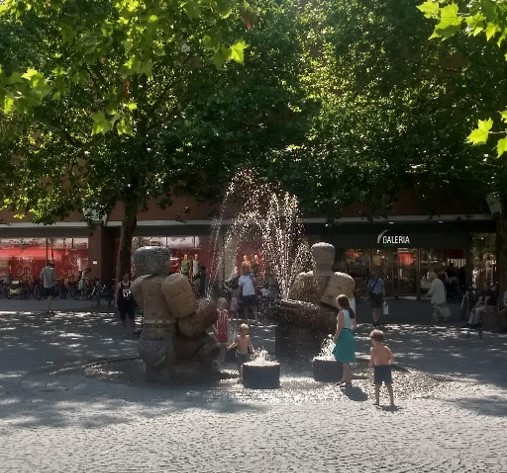I always smile when I see children playing in the parks. It is not something I am used to. In cities, we usually meet adults and sometimes children but held very closely to their parents. Cities struggle to be at a human scale but certainly, no city is at the children’s scale. Nevertheless, in Munich I noticed a safer environment which allows children to acquire more freedom.
In winter, it is not uncommon to meet children pulling their sledge to the park. In the summer evenings you would often see children playing until late on open playgrounds. I also once saw the children of a pre-school having their break on the square in front of their school. The public sphere is trusted enough to let play those fragile figures.
As we could usually think, the best way to keep children safe is to enclose them behinds fences to separate them from the dangerous surroundings. One could have a quite other approach. In a talk given at the ENSA Strasbourg by Tina Saaby, architect and urbanist for the city of Copenhagen, it is explained that the freedom given to the children ensures their security. Schools in Copenhagen have mostly playgrounds open to the street. There is no massive fence to keep in children like you would keep in cattle. Instead, the public space merges with the playground. This approach teaches the children to interact with the city’s dynamic and to be aware of the dangers. They learn to not get close to the road and to stay in the secured area. This allows them later to play safely in the open public spaces. (Picture depicting a playground in a little town of France where, despite the natural environment, a 2m fence is erected.)
Children in Munich are of course mostly supervised like elsewhere but this agglomeration of adults establishes a natural protected perimeter and a lively environment. An example of a tacit delimitation of such a playground is on Rotkreuzplatz. This square is situated at the crossing of multi-lane streets, tram and bus lines. There are shops all around and it is buzzing with activity mostly in mornings and at lunch times. The circular geometry of the square is delimited by brick benches which enclose the space. Central fountains and a slight slope towards them concentrates the attention of the children. The side trees further enclose this space and offer comfortable shade for the adults standing and chatting around. The peripheral gathering ensures benevolent supervision of the children of all ages. Moreover, the rough surface of the pavements suggests the possibility for the children to run barefoot as it doesn’t look like a street.
Children illustrate how comfortable and safe an environment is so we should not under evaluate their instinct – and of course the one of their parents. Playgrounds would be a topic to discuss in its self but in the meantime check out the works of Open Fabric, a landscape architecture firm which has a very interesting approach to play grounds and promotes the freedom for children to misuse and invent the function of public furniture and spaces.




